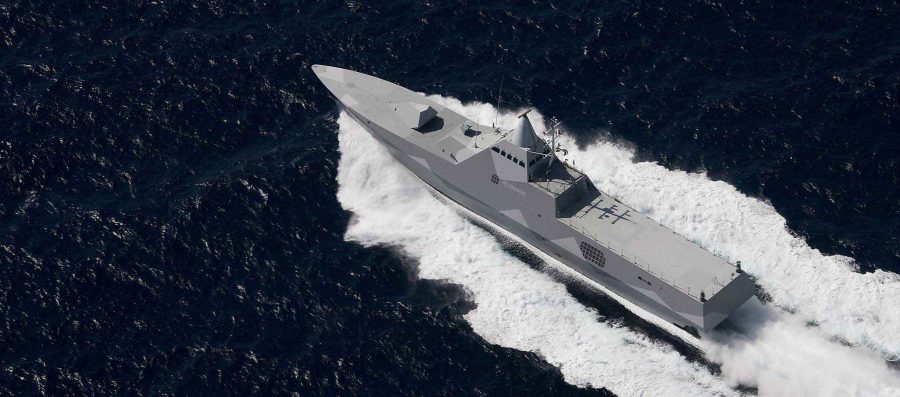
It’s time for the Royal Australian Navy to break out of a 20th-century force design mindset and embrace the robotic revolution at sea.
As part of the debate surrounding the Pacific 2019 and Sea Power conferences, I argued that even with the recapitalisation now underway, the navy would remain seriously undergunned to deal with possible scenarios emerging in our region.
The RAN’s future surface warfare plans are based on its three Hobart-class air warfare destroyers and nine Hunter-class frigates now being built. The first new frigate won’t appear until the end of this decade, and the eight Anzac-class frigates will serve in the interim. A feature of Australia’s naval mindset that carries over from the current to the next generation of warships is a lack of long-range anti-surface warfare capabilities. The Hobart class carries only eight subsonic, short-range Harpoon anti-ship missiles, and the frigate is similarly constrained in the number of anti-surface weapons it can carry.
The problem we face is too few missiles on too few (very complex and expensive) hulls.
A small, highly advanced fleet is fine as long as Australia isn’t challenged by a major power. Such vessels can play a role in coalition operations and support global deployments, as in the Middle East. If there’s no serious challenge in Australia’s backyard, a larger fleet isn’t necessary.
But we face a very different emerging reality. The rapidly growing PLA Navy is overtaking the US Navy in ship numbers, and is steadily eroding the US’s qualitative lead while expanding China’s ability to project power into our maritime approaches. China has reportedly negotiated access to Cambodia’s Ream naval base, and its de facto control of the South China Sea expands its ability to operate further south, notably with aircraft carriers in its South Sea Fleet.
A recent standoff between China and Indonesia over the Natuna Islands is a worrying sign that China won’t limit its maritime claims. China’s expanding presence in the Southwest Pacific is ringing alarm bells in Canberra because it raises the prospect of a future military staging post within striking distance of Australia’s east coast.
If Beijing increases that pressure, Australia should increase the size of its navy beyond the plan laid out in the 2016 integrated investment program. Rather than reducing the number of Hunter-class frigates to fund other platforms, we should develop a new, mid-level capability by acquiring larger numbers of advanced, but off-the-shelf, small surface combatants.
These would be fast, missile-armed corvette-type vessels, a good example of which is the Swedish Saab Visby class. Saab is already developing a next-generation design to follow the Visby. These smaller vessels could be acquired in large numbers relatively cheaply to significantly expand the fleet. They’d be optimised for offensive strike and intelligence, surveillance and reconnaissance missions—akin to ‘see, shoot and scoot’. They’d be stealthy and would ideally operate unmanned aerial vehicles for surveillance and strike tasks.
This new capability would allow distributed maritime operations for sea denial. We can’t do that with only 12 large ships. A report by the US Center for Strategic and Budgetary Assessments highlighted the value of larger numbers of small surface combatants—referred to as ‘optionally unmanned corvettes’ or DDCs—with a small crew and equipped primarily with offensive weapons. The US Navy is moving down this path and the RAN risks being left behind. Australia should remain responsive to changes in an emerging US Navy that could, in 10 years, look radically different.
It’s time for Australia to be bold and imaginative with fleet design and mitigate the risk that comes with a small boutique fleet which, while very capable, is limited by the number of hulls, and increasingly vulnerable in the face of China’s rapidly growing naval capability.
We should also embrace unmanned systems. The US is investigating the potential of unmanned surface vessels such as the Sea Hunter, and underwater vehicles such as Orca, and Australia should do likewise.
With the large fleet combatants such as the Hobart-class and Hunter-class vessels operating as part of a coalition task force or leading an ADF joint task force, it’s the robots that should go into harm’s way on, and under, the waves—and in the air too. A mix of manned and unmanned platforms exploiting our strategic geography to deny our seas to an enemy can be more difficult to defeat than a small number of large, high-end crewed vessels. Such an unmanned force can emphasise offence rather than fleet defence to protect a human crew.
Smaller naval vessels have less range than larger ships so must be based forward or replenished at sea. Use of the naval base at Manus Island and further development of Australia’s Cocos (Keeling) Islands in the Indian Ocean could be excellent starting points, and deployable tenders could enable ‘pop-up’ forward bases to support multiple DDCs and unmanned surface vessels.
We need to recognise the advantages of using distributed mass in warfare and exploiting our strategic geography. Our capability planning is based on the assumption that a knowledge edge will enable us to carry out precision strikes from a limited number of platforms. That can now be challenged by the rapid growth of anti-access/area-denial capabilities, as well as an enemy’s ability to attack key elements of our networked command structures and to project power at greater range.
If we continue to rely on a small, high-end force and don’t adapt to change, we’ll place ourselves at a disadvantage in a future war. As the saying goes, quantity has a quality all of its own.

